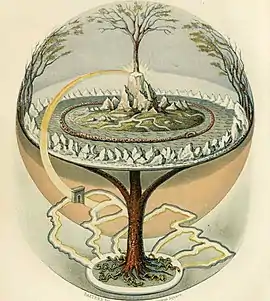Ultimate reality
Ultimate reality is "something that is the supreme, final, and fundamental power in all reality."[1]
Buddhism
In Theravada Buddhism, Nirvana is ultimate reality.[2] Nirvana is described in negative terms; it is unconstructed and unconditioned.[3] In some strands of Mahayana Buddhism, the Buddha-nature or the Dhammakaya is seen as ultimate reality.[4] Other strands of Buddhism reject the notion of ultimate reality, regarding any existent as empty (sunyata) of inherent existence (svabhava).[5]
Hinduism
In Hinduism, Brahman connotes the highest Universal Principle, the Ultimate Reality in the universe.[6][7][8] In major schools of Hindu philosophy, it is the material, efficient, formal and final cause of all that exists.[7][9][10] It is the pervasive, genderless, infinite, eternal truth and bliss which does not change, yet is the cause of all changes.[6][8] [11] Brahman as a metaphysical concept is the single binding unity behind diversity in all that exists in the universe.[6][12]
Representing ultimate reality

According to Dadosky, the concept of "ultimate reality" is difficult to express in words, poetry, mythology, and art. Paradox or contradiction is often used as a medium of expression because of the "contradictory aspect of the ultimate reality".[13]
According to Mircea Eliade, ultimate reality can be mediated or revealed through symbols.[14] For Eliade the "archaic" mind is constantly aware of the presence of the Sacred, and for this mind all symbols are religious (relinking to the Origin). Through symbols human beings can get an immediate "intuition" of certain features of the inexhaustible Sacred. The mind makes use of images to grasp the ultimate reality of things because reality manifests itself in contradictory ways and therefore can't be described in concepts. It is therefore the image as such, as a whole bundle of meaning, that is "true" (faithful, trustworthy).[14] Eliade says :[15]
the sacred is equivalent to a power, and, in the last analysis, to reality. The sacred is saturated with being. Sacred power means reality and at the same time enduringness and efficacy. The polarity sacred-profane is often expressed as opposition between real and unreal or pseudoreal. [...] Thus it is easy to understand that religious man deeply desires to be, to participate in reality, to be saturated with power.
Common symbols of ultimate reality include world trees, the tree of life, microcosm, fire, children,[16] circles, mandalas, and the human body.
See also
References
- Merriam-Webster Dictionary, Ultimate reality
- Harvey 2001, p. 95, 97.
- Harvey 2001, p. 97-98.
- Harvey 2001, p. 109.
- Wedemeyer 2012, p. 52.
- Lochtefeld, James G. (2002). The Illustrated Encyclopedia of Hinduism. 1. The Rosen Publishing Group. p. 122. ISBN 978-0823931798.
- P. T. Raju (2006), Idealistic Thought of India, Routledge, ISBN 978-1406732627, page 426 and Conclusion chapter part XII
- Fowler 2002, pp. 49–55 (in Upanishads), 318–319 (in Vishistadvaita), 246–248 and 252–255 (in Advaita), 342–343 (in Dvaita), 175–176 (in Samkhya-Yoga).
- Mariasusai Dhavamony (2002), Hindu-Christian Dialogue: Theological Soundings and Perspectives, Rodopi Press, ISBN 978-9042015104, pages 43–44
- For dualism school of Hinduism, see: Francis X. Clooney (2010), Hindu God, Christian God: How Reason Helps Break Down the Boundaries between Religions, Oxford University Press, ISBN 978-0199738724, pages 51–58, 111–115;
For monist school of Hinduism, see: B. Martinez-Bedard (2006), Types of Causes in Aristotle and Sankara, Thesis – Department of Religious Studies (Advisors: Kathryn McClymond and Sandra Dwyer), Georgia State University, pages 18–35 - Brodd, Jeffrey (2009). World Religions: A Voyage of Discovery (3rd ed.). Saint Mary's Press. pp. 43–47. ISBN 978-0884899976.
- Fowler 2002, pp. 50–53.
- Dadosky, 2004. p. 86
- Dadosky, 2004. p. 85
- Dadosky, 2004. p. 100
- See George MacDonald's The Golden Key
Sources
- John Daniel Dadosky. The Structure of Religious Knowing: Encountering the Sacred in Eliade and Lonergan. State University of New York Press, 2004. ISBN 0791460614.
- Fowler, Jeaneane D. (2002), Perspectives of Reality: An Introduction to the Philosophy of Hinduism, Sussex Academic Press, ISBN 978-1-898723-93-6
- Harvey, Peter, Buddhism, Bloomsbury Publishing
- Wedemeyer, Christian K. (2012), Making Sense of Tantric Buddhism: History, Semiology, and Transgression in the Indian Traditions, Columbia University Press
Further reading
- Neville, Robert C. (2001), Ultimate Realities: A Volume in the Comparative Religious Ideas Project, SUNY Press